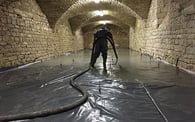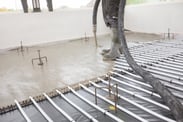What Is A Flow Test?
Flow testing of liquid screed is carried out to determine the flowability of the screed. For this, a stainless-steel cone is placed on the clean dry slump board. The cone is then filled with screed. Once full the cone is removed, and the spread is measured to determine the flowability of the screed before application. There are various types of screed applications; bonded screeds, unbonded screeds, floating screeds and underfloor heating screeds.
- A bonded screed is, simply, a screed that is bonded to a substrate. This would usually be to a concrete slab or such as a beam and block floor.
- An unbonded screed is, exactly as its name suggests, one that is not bonded to its substrate.
- This simply mean that the screed is overlayed on something that is compressible and not rigid.
- Underfloor heating screed is essentially screed laid over your underfloor heating system
Why Should A Flow Test Be Carried Out On Site?
A flow test should be carried out immediately before you start installation. This is very important as it ensures that the screed has the correct consistency and is workable.
A non-workable screed can occur when:
- The mixture is too wet – this allows course aggregates to settle at the bottom and results in the screed becoming a non-uniform composition.
- The mixture is too dry – this will result in the screed being difficult to handle and place correctly in position.
You should achieve a flow of 220mm-250mm from a flow test.
If this is not achieved and the flow is too low (less than 220mm), you need the addition of water to achieve the required flow tolerance. This is carried out gradually at 10 litre intervals with 5 minutes of further mixing, then another flow test can be carried out. If the flow is too high (more than 250mm) , allow for 10 minutes of mixing and then retest.
Benefits Of Flow Testing Cemfloor On Site.
Flow tests should always be carried out on Cemfloor at the production plant first and then most importantly on site before installation to ensure correct workability. The main benefit of this is no drying shrinkage or any related problems. As well as giving an accurate measurement of the workability of the concrete, the flow test also gives an indication of the cohesion.
How A Flow Test Is Carried Out Onsite, Step By Step.
Step 1: Collect A Sample Of The Liquid Screed.


Step 2: The Cone Is Placed In The Center Of The Clean Dry Slump Board And Filled With The Fresh Liquid Screed.


Step 3: Wait 5-10 Seconds And Then Lift The Cone.


Step 4: Once The Cone Is Lifted The Liquid Screed Starts To Flow. After This Has Been Done, You Then Measure The Diameter Of The Screed.

We fully understand the importance of flow testing on site as it ensures that our quality is never compromised and guarantees a high performance, free flowing, self-compacting liquid screed.
If you wish to learn more about Cemfloor, talk to us today on +353 94 9553900 if calling from Ireland or 01415 307 587 if calling from the UK.







.png?width=300&height=122&name=Untitled%20design%20(34).png)
